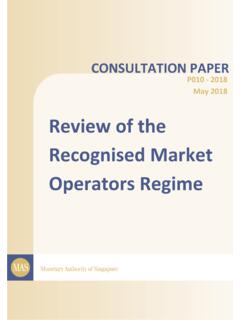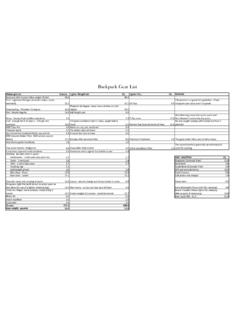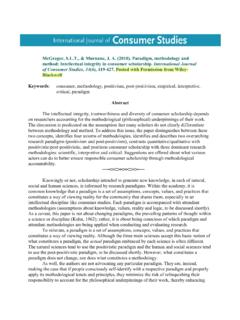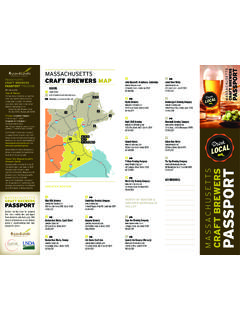Transcription of Analysis of an Electronic Voting System
1 This paper, copyright the IEEE, appears inIEEE Symposium on Security and Privacy 2004. IEEE ComputerSociety Press, May 2004. This paper previously appeared as Johns Hopkins University Information SecurityInstitute Technical Report TR-2003-19, July 23, of an Electronic Voting SystemTADAYOSHIKOHNO ADAMSTUBBLEFIELD AVIELD. RUBIN DANS. WALLACH February 27, 2004 AbstractWith significant federal funds now available to replace outdated punch-card and mechanicalvoting systems, municipalities and states throughout the are adopting paperless Electronic votingsystems from a number of different vendors. We present a security Analysis of the source code to one suchmachine used in a significant share of the market. Our Analysis shows that this Voting System is far beloweven the most minimal security standards applicable in other contexts. We identify several problemsincluding unauthorized privilege escalation, incorrect use of cryptography, vulnerabilities to networkthreats, and poor software development processes.
2 We show that voters, without any insider privileges,can cast unlimited votes without being detected by any mechanisms within the Voting terminal , we show that even the most serious of our outsider attacks could have been discoveredand executed without access to the source code. In the face of such attacks, the usual worries aboutinsider threats are not the only concerns; outsiders can do the damage. That said, we demonstrate thatthe insider threat is also quite considerable, showing that not only can an insider, such as a poll worker,modify the votes, but that insiders can also violate voter privacy and match votes with the voters whocast them. We conclude that this Voting System is unsuitable for use in a general election. Any paperlesselectronic Voting System might suffer similar flaws, despite any certification it could have otherwisereceived. We suggest that the best solutions are Voting systems having a voter-verifiable audit trail, where a computerized Voting System might print a paper ballot that can be read and verified by the voter.
3 Dept. of Computer Science and Engineering, University of California at San Diego, 9500 Gilman Drive, La Jolla, California92093, USA. URL: Most of this workwas performed while visiting the Johns Hopkins University Information Security Institute. Supported by a National Defense Scienceand Engineering Graduate Fellowship. Information Security Institute, Johns Hopkins University, 3400 North Charles Street, Baltimore, Maryland 21218, USA. URL: astubble. Information Security Institute, Johns Hopkins University, 3400 North Charles Street, Baltimore, Maryland 21218, USA. URL: Dept. of Computer Science, Rice University, 3121 Duncan Hall, 6100 Main Street, Houston, Texas 77005, USA. URL: Introduction32 System overview53 the lack of cryptography: Creating homebrew smartcards .. multiple votes .. administrator and poll worker functionality .. 104 Election configurations and election with the System configuration .. with ballot definitions .. legitimate Voting terminals.
4 Management and other cryptographic issues with the vote and audit records .. with election results and linking voters with their votes .. logs .. the start of an election .. 175 Software legacy .. style .. process .. completeness and correctness .. 206 Conclusions2121 IntroductionElections allow the populace to choose their representatives and express their preferences for how they willbe governed. Naturally, the integrity of the election process is fundamental to the integrity of democracyitself. The election System must be sufficiently robust to withstand a variety of fraudulent behaviors andmust be sufficiently transparent and comprehensible that voters and candidates can accept the results ofan election. Unsurprisingly, history is littered with examples of elections being manipulated in order toinfluence their design of a good Voting System , whether Electronic or using traditional paper ballots or mechanicaldevices, must satisfy a number of sometimes competing criteria.
5 Theanonymityof a voter s ballot must bepreserved, both to guarantee the voter s safety when Voting against a malevolent candidate, and to guaranteethat voters have no evidence that proves which candidates received their votes. The existence of suchevidence would allow votes to be purchased by a candidate. The Voting System must also betamper-resistantto thwart a wide range of attacks, including ballot stuffing by voters and incorrect tallying by factor, as shown by the so-called butterfly ballots in the Florida 2000 presidential election, is theimportance ofhuman factors. A Voting System must be comprehensible to and usable by theentirevotingpopulation, regardless of age, infirmity, or disability. Providing accessibility to such a diverse population isan important engineering problem and one where, if other security is done well, Electronic Voting could bea great improvement over current paper systems. Flaws in any of these aspects of a Voting System , however,can lead to indecisive or incorrect election Voting SYSTEMS.
6 There have been several studies on using computer technologies to im-prove elections [4, 5, 20, 21, 25]. These studies caution against the risks of moving too quickly to adoptelectronic Voting machines because of the software engineering challenges, insider threats, network vulner-abilities, and the challenges of a result of the Florida 2000 presidential election, the inadequacies of widely-used punch card vot-ing systems have become well understood by the general population. Despite the opposition of computerscientists, this has led to increasingly widespread adoption of direct recording Electronic (DRE) votingsystems. DRE systems, generally speaking, completely eliminate paper ballots from the Voting process. Aswith traditional elections, voters go to their home precinct and prove that they are allowed to vote there,perhaps by presenting an ID card, although some states allow voters to cast votes without any identificationat all. After this, the voter is typically given a PIN, a smartcard, or some other token that allows them toapproach a Voting terminal, enter the token, and then vote for their candidates of choice.
7 When the voter sselection is complete, DRE systems will typically present a summary of the voter s selections, giving thema final chance to make changes. Subsequent to this, the ballot is cast and the voter is free to most fundamental problem with such a Voting System is that the entire election hinges on the cor-rectness, robustness, and security of the software within the Voting terminal. Should that code have security-relevant flaws, they might be exploitable either by unscrupulous voters or by malicious insiders. Suchinsiders include election officials, the developers of the Voting System , and the developers of the embeddedoperating System on which the Voting System runs. If any party introduces flaws into the Voting System soft-ware or takes advantage of pre-existing flaws, then the results of the election cannot be assured to accuratelyreflect the votes legally cast by the there has been cryptographic research on Electronic Voting [13], and there are new approachessuch as [6], currently the most viable solution for securing Electronic Voting machines is to introduce a voter-verifiable audit trail [10, 20].
8 A DRE System with a printer attachment, or even a traditional opticalscan System ( , one where a voter fills in a printed bubble next to their chosen candidates), will satisfythis requirement by having a piece of paper for voters to read and verify that their intent is correct paper is stored in ballot boxes and is considered to be the primary record of a voter s intent. If, for3some reason, the printed paper has some kind of error, it is considered to be a spoiled ballot and can bemechanically destroyed, giving the voter the chance to vote again. As a result, the correctness of any votingsoftware no longer matters; either a Voting terminal prints correct ballots or it is taken out of service. If thereis any discrepancy in the vote tally, the paper ballots will be available to be recounted, either mechanicallyor by hand. (A verifiable audit trail does not, by itself, address voter privacy concerns, ballot stuffing, ornumerous other attacks on elections.) CERTIFIED DRESYSTEMS.
9 Many government entities have adopted paperless DRE systems withoutappearing to have critically questioned the security claims made by the systems vendors. Until recently,such systems have been dubiously certified for use without any public release of the analyses behind thesecertifications, much less any release of the source code that might allow independent third parties to performtheir own analyses. Some vendors have claimed security through obscurity as a defense, despite thesecurity community s universally held belief in the inadequacy of obscurity to provide meaningful protection[18].Indeed, the CVS source code repository for Diebold s AccuVote-TS DRE Voting System recently ap-peared on the Internet. This appearance, announced by Bev Harris and discussed in her book,Black BoxVoting[14], gives us a unique opportunity to analyze a widely used, paperless DRE System and evaluate themanufacturer s security claims. Jones discusses the origins of this code in extensive detail [17].
10 Diebold svoting systems are in use in 37 states, and they are the second largest and the fastest growing vendor ofelectronic Voting machines. We only inspected unencrypted source code, focusing on theAVTSCE, orAccuVote-TS version 4, tree in the CVS repository [9]. This tree has entries dating from October 2000 andculminates in an April 2002 snapshot of version of the AccuVote-TS System . From the comments inthe CVS logs, the AccuVote-TS version 4 tree is an import of an earlier AccuTouch-CE tree. We did nothave source code to Diebold s GEMS back-end election management OF RESULTS. We discovered significant and wide-reaching security vulnerabilities in the versionof the AccuVote-TS Voting terminal found in [9] (see Table 1). Most notably, voters can easily program theirown smartcards to simulate the behavior of valid smartcards used in the election. With such homebrew cards,a voter can cast multiple ballots without leaving any trace. A voter can also perform actions that normallyrequire administrative privileges, including viewing partial results and terminating the election early.






